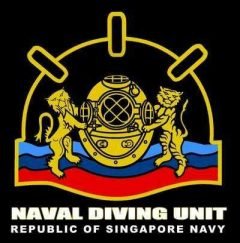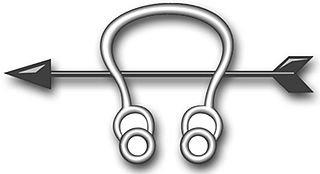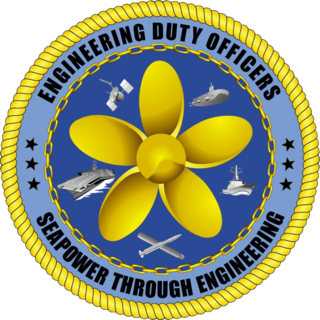
Professional diving is diving where the divers are paid for their work. The procedures are often regulated by legislation and codes of practice as it is an inherently hazardous occupation and the diver works as a member of a team. Due to the dangerous nature of some professional diving operations, specialized equipment such as an on-site hyperbaric chamber and diver-to-surface communication system is often required by law, and the mode of diving for some applications may be regulated.
Underwater divers may be employed in any branch of an armed force, including the navy, army, marines, air force and coast guard. Scope of operations includes: search and recovery, search and rescue, hydrographic survey, explosive ordnance disposal, demolition, underwater engineering, salvage, ships husbandry, reconnaissance, infiltration, sabotage, counterifiltration, underwater combat and security.

The diver insignia are qualification badges of the uniformed services of the United States which are awarded to servicemen qualified as divers. Originally, the diver insignia was a cloth patch decoration worn by United States Navy divers in the upper-portion of the enlisted service uniform's left sleeve during the first part of World War II, when the rating insignia was worn on the right sleeve. When enlisted rating insignia were shifted to the left sleeve in late World War II, the patch shifted to the upper right sleeve. The diving patch was created during World War II, and became a breast insignia in the late 1960s.

Insignias and badges of the United States Navy are military badges issued by the United States Department of the Navy to naval service members who achieve certain qualifications and accomplishments while serving on both active and reserve duty in the United States Navy. Most naval aviation insignia are also permitted for wear on uniforms of the United States Marine Corps.

Naval Diving Unit (NDU) is a special forces formation within the Republic of Singapore Navy which specialises in maritime counterterrorism operations, commando warfare, sabotage, demolitions, underwater salvage, and explosive ordnance disposal.

A clearance diver was originally a specialist naval diver who used explosives underwater to remove obstructions to make harbours and shipping channels safe to navigate, but later the term "clearance diver" was used to include other naval underwater work. Units of clearance divers were first formed during and after the Second World War to clear ports and harbours in the Mediterranean and Northern Europe of unexploded ordnance and shipwrecks and booby traps laid by the Germans.

United States Navy Explosive Ordnance Disposal technicians render safe all types of ordnance, including improvised, chemical, biological, and nuclear. They perform land and underwater location, identification, render-safe, and recovery of foreign and domestic ordnance. They conduct demolition of hazardous munitions, pyrotechnics, and retrograde explosives using detonation and burning techniques. They forward deploy and fully integrate with the various Combatant Commanders, Special Operations Forces (SOF), and various warfare units within the Navy, Marine Corps, Air Force and Army. They are also called upon to support military and civilian law enforcement agencies, as well as the Secret Service.

A United States Navy diver refers to a service personnel that may be a restricted fleet line officer, civil engineer corps (CEC) officer, Medical Corps officer, or an enlisted who is qualified in underwater diving and salvage. Navy divers serve with fleet diving detachments and in research and development. Some of the mission areas of the Navy diver include: marine salvage, harbor clearance, underwater ship husbandry and repair, submarine rescue, saturation diving, experimental diving, underwater construction and welding, as well as serving as technical experts to the Navy SEALs, Marine Corps, and Navy EOD diving commands.

Mineman is a United States Navy occupational rating.

Sonar technician is a United States Navy occupational rating.

The US employs divers in several branches of the armed forces, including the navy, army, marines, air force and coast guard.

An engineering duty officer (EDO) is a restricted line officer in the United States Navy, involved with the design, acquisition, construction, repair, maintenance, conversion, overhaul and disposal of ships, submarines, aircraft carriers, and the systems installed aboard. As of August 1, 2016, there are approximately 835 engineering duty officers on active duty in the U.S. Navy, representing approximately 2 percent of its active-duty commissioned officers.
The United States Navy job rating of electronics technician (ET) is a designation given by the Bureau of Naval Personnel (BUPERS) to enlisted members who satisfactorily complete initial Electronics Technician "A" school training.

Army engineer divers are members of national armies who are trained to undertake reconnaissance, demolition, and salvage tasks underwater. These divers have similar skills and qualifications as professional divers. In the United States Army, they are members of the Corps of Engineers. In the British Army they may be Royal Engineer Divers or Commando Engineer Divers.
Harbor Clearance Unit One, a United States Navy unit, was commissioned in February 1966 with the mission "....to provide salvage repair; diving and rescue services in rivers and restricted waters and to conduct harbor and river clearance operations in the Western Pacific." Some contended that the intended mission was to provide rapidly deployable diving and salvage teams in direct support of the Vietnam War. Whatever the actual intent was, the concept was proven so effective that the command was moved to continuous salvage service at Pearl Harbor, Hawaii, near the end of the Vietnam War.

The following index is provided as an overview of and topical guide to underwater diving:

Underwater Construction Teams (UCT) are the United States Navy Seabees' underwater construction units numbered 1 and 2 that were created in 1974. A team is composed of divers qualified in both underwater construction and underwater demolition. Possible tasks can be: battle damage repairs, structural inspections and accessments, demolition of waterline facilities or submerged obstructions, installation of submerged surveillance systems, or harbor and channel clearance. As needed, teams may test and or evaluate new or existing aquatic systems or equipment. Extending construction, whether vertical or horizontal, beyond the shoreline and waterline is their specialty. Reflecting Seabee tradition, teams are expected to execute underwater construction anywhere, anytime, under any conditions.













